全文HTML
--> --> -->此外, 同其他复杂分子动力学和流体力学问题一样, 目前还缺少严格的理论来准确预测特定结构阀门条件下的束流膨胀过程, 并且关于超声分子束速度[15—18]和密度[19,20]的模拟研究(直接数值模拟DNS, 大涡模拟LES等)[21—24]大多集中在粗糙真空度(1—103 Pa)环境下产生的超声束流以及超声分子束在近域(x/d < 100)的寂静区、马赫盘区以及中间域的束流特性分布, 其中x代表出射距离, d代表喷嘴直径, 较少涉及分子束在长距离下远域(x/d > 300)的束流特性的空间演化.
另外, 理想气体超声分子束的热力学理论研究表明, 分子束平均速度仅与气体分子量和源温度[25]有关, 应同源压强无关. 但许多实验研究发现, 除了温度效应外, 源压强[8,26,27]也会影响分子束的终端速度. 其中, Reisinger等[27]通过飞行时间质谱法在高真空环境下测量了源压强对超声分子束速度的影响, 结果表明对于温度在310 K的超声D2束, 当源压强由10 bar增加至50 bar时, 其速度由1925 m/s增加到2025 m/s. 此外, 在自由膨胀分子束速度的研究中, Christen和Rademann等[28]考虑了比热容比γ在自由膨胀分子束的初始和末态的变化, 利用实际流体计算代替了理想气体计算模型(采用定值比热容比, 他们之间的主要区别是在液气相变附近和临界点附近), 计算了二氧化碳CO2自由膨胀分子束的终端平均速度. 结果表明在10—100 bar范围内, CO2超声束流的速度随源压强的增大而逐渐下降, 且在源压强小于80 bar时大于理想气体理论预测速度, 在源压强大于80 bar时小于理想气体理论预测速度. 因此, 源压强对超声分子束速度的影响仍然是一个值得进一步研究的内容.
目前已发展出多种测量流体速度的方法并用于超声分子束的实验研究, 例如粒子图像测速法[29]、激光多普勒测速法[30]以及飞行时间质谱法(TOFMS)[15]. 其中, TOFMS法是测量超声分子束速度的一种常用方法, 该方法将分子束电离产生离子束, 通过测量给定距离下离子的飞行时间来测量超声分子束的速度, 该方法的测量精度能够达到很高的水平, 如误差为0.3%[17,18]. 使用该测量方法可精确测量超声分子束中心极小范围(平方微米量级)内的速度分布, 非常适合研究基于超声分子束的原子分子物理. 但该方法对实验条件的要求较高, 包括需要足够短的超声分子束脉冲持续时间(小于20 μs)以避免分子束内部分子之间的干扰, 需要多级差分真空系统以维持严格的高真空度(10–7 Pa以下)[8], 同时还需要高精度的电离控制系统以保证离子的电荷态等. 并且, 这种测量方式不易与其他系统兼容, 灵活性稍差. 此外, TOFMS法也不适用于某些研究领域, 如航空器的超声喷流推进研究或磁约束聚变领域的超声分子束注入研究. 这些研究领域需要关注的是受环境流体卷吸影响的、较大范围内的(大于平方毫米量级)分子束的平均速度演变, 因此TOFMS法无法满足这些领域的测量要求, 需要新的测量方法.
本文针对超声分子束在磁约束聚变中的加料注入领域, 在长距离真空装置内产生了6种气体(H2, D2, N2, Ar, He和CH4)的自由膨胀超声分子束, 并基于麦克风的简洁高效的超声分子束速度和密度的测量方法[31,32], 研究了源压强(10—50 bar)对较大范围内所述6种分子束的平均速度的远域轴向分布的影响, 以及源温度(80—300 K)与H2和D2分子束的飞行速度之间的关系. 研究结果有助于进一步探索超声分子束特性在远域空间的演化规律以及超声分子束速度与源压强的关系, 并有助于超声分子束在聚变堆加料技术中的应用.
 图 1 超声分子束速度测量装置示意图
图 1 超声分子束速度测量装置示意图Figure1. Schematic diagram of supersonic molecular beam velocity measuring device.
超声分子束的测量系统是基于麦克风(驻极体结构)构建的, 当超声喷流撞击麦克风时, 麦克风振膜发生形变引起电容变化, 通过外接的RC电路转换为电信号, 并为示波器记录[31]. 信号由一个正脉冲和一个负脉冲组成, 对记录的信号进行分析后, 发现正脉冲对应麦克风被分子束压缩的过程, 负脉冲对应麦克风恢复的过程[31], 正负脉冲的时间间隔对应喷气时间, 脉冲信号的幅度反映了分子束的密度, 而正脉冲信号的起始时间则反映了超声分子束输运到麦克风位置处的时间, 详细结果参见文献[31].
速度的测量基于飞行时间法. 通过测量图1中4个不同轴向位置(310, 700, 1085和1695 mm)处的超声分子束作用麦克风产生的信号的起始时间, 可得到距离-时间曲线, 进而对相邻两点拟合计算得到超声分子束在轴向的飞行速度.由于较难准确获得从超声分子束产生到麦克风产生信号之间的绝对时间延迟, 因此实验不能给出喷嘴到第一个麦克风距离段超声分子束的平均速度. 此外, 由于麦克风的有效面积为7.07 mm2, 产生的信号反映轰击到该区域内所有分子的集体作用, 因此计算结果反映的是束流在该区域内的平均速率.
实验发现分子束密度(粒子数)对麦克风信号的时间响应具有较大影响, 信号定时时间将随着信号幅度的增大而减小, 但当麦克风饱和后, 定时时间趋于稳定[31]. 而飞行时间法是用给定距离下两点的时间差来计算平均速度, 要求这两点的定时尽可能准确以保证速度计算的准确性, 即这两点的密度对定时尽量无影响. 由于麦克风在饱和后可保证定时时间不变, 从而避免了分子束密度对定时的影响, 因此本文在研究分子束速度的轴向分布时, 采用最大源压强(50 bar)产生的6种超声分子束进行测量, 此时麦克风完全饱和, 保证了速度测量的准确性. 而在研究气压对超声分子束速度的影响时, 采用在距离喷嘴较近(310—700 mm)处的测量结果, 在此区间内分子束密度相对较大且变化缓慢[31], 可保证速度测量结果较为准确.
3.1.定时误差
首先, 研究了系统的定时误差. 针对同一实验条件进行了多次测量, 获得了定时差值结果以及频率分布如图2所示, 结果表明时间晃动的标准差为0.0097 ms. 这一波动来自于实验背景噪声和射流的不稳定性, 此外也包含了阀门开启时间的抖动以及麦克风响应的抖动误差, 它们会引起拟合速度结果的误差. 对引起的拟合速度误差verr进行估算, 如下式: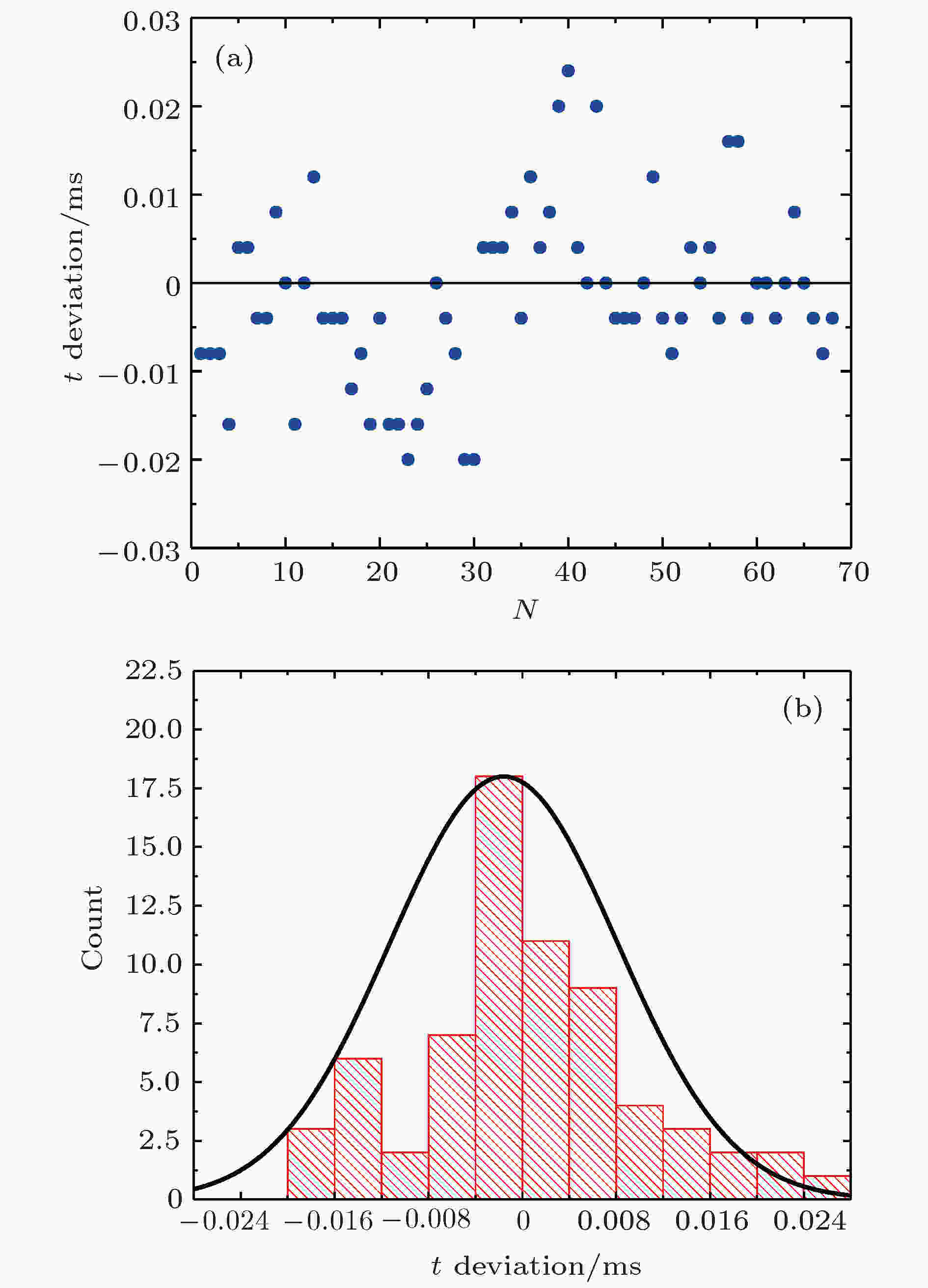 图 2 多次测量定时误差 (a)和频率分布直方图(b)
图 2 多次测量定时误差 (a)和频率分布直方图(b)Figure2. Timing error (a) and frequency distribution histogram (b) of multiple measurements
2
3.2.超声分子束理论极限速度
超声分子束的终端速度可以通过分子束的初始和末态状态决定. 在高气压下, 气体黏度和传热的影响可以忽略, 气流可以看作是绝热等熵膨胀的[34], 有能量守恒:





2
3.3.常温下六种分子束的速度
对测量的距离-时间结果的每相邻的两个距离点进行拟合, 由于分别在四个轴向位置处进行了测量, 可得到分子束在三个距离段上的平均速度, 距离段Ⅰ对应310—700 mm, 距离段Ⅱ对应700—1085 mm, 距离段Ⅲ对应1085—1695 mm. 这样就得到了6种(H2, D2, N2, Ar, He, CH4)分子束在远域空间(310—1695 mm)的轴向速度分布, 如图3所示. 结果表明, 沿着束流出射方向, H2和D2分子束的速度从距离段I到距离段Ⅱ变化不大, 但在距离段Ⅲ明显下降: 其中H2下降140 m/s, D2下降120 m/s. 而CH4和N2的速度在各距离段变化较小, 分别下降了为81 m/s和53 m/s. 其原因很可能是受真空靶室的限制作用, 与靶室壁碰撞的分子反弹影响真空环境, 在背景真空的粒子作用下, 导致气流在远域空间经碰撞形成等温湍流, 从而引起分子束速度逐渐下降.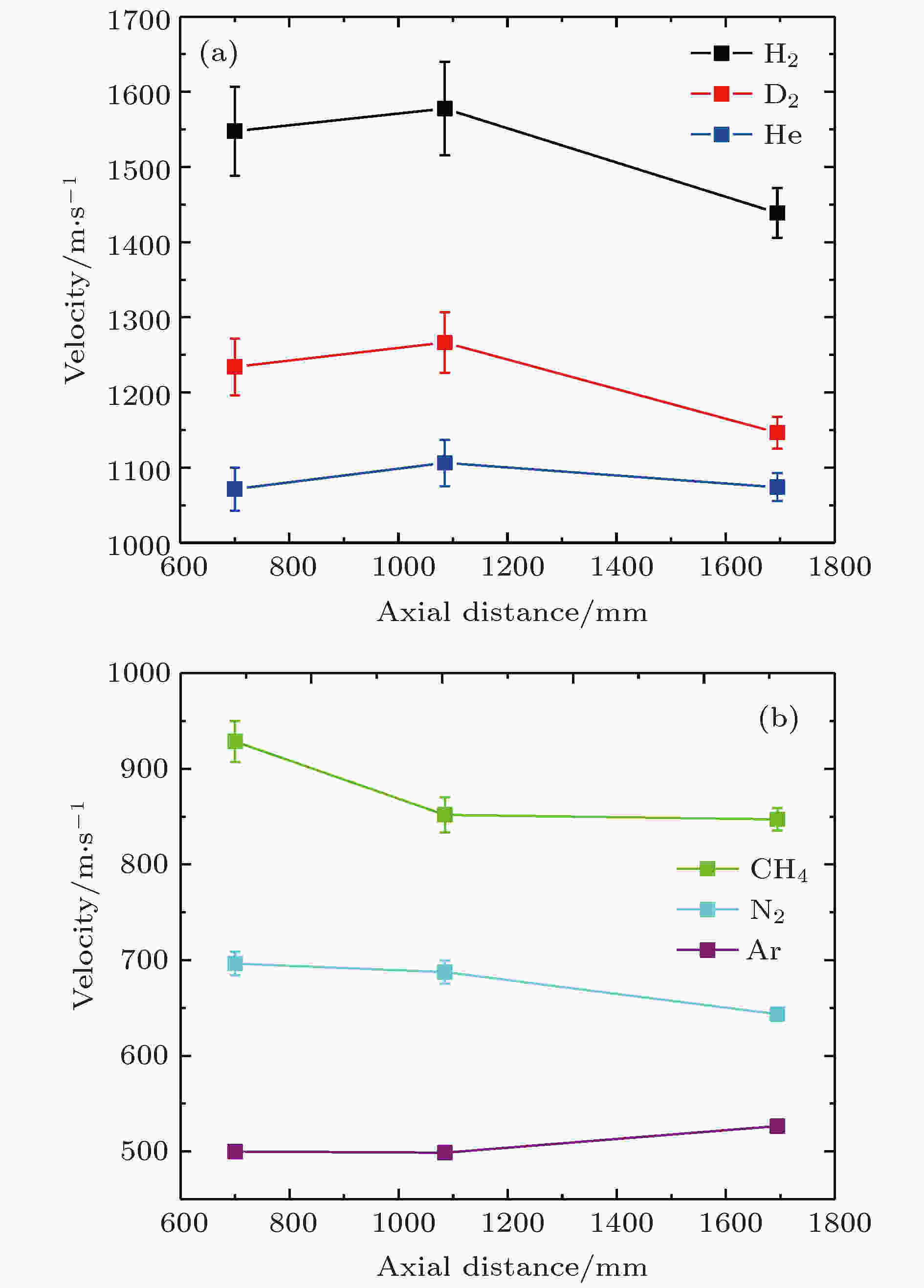 图 3 压强P0为50 bar时, 超声分子束速度随轴向距离的变化规律 (a) H2, D2和He的速度结果; (b) N2, Ar和CH4的速度结果
图 3 压强P0为50 bar时, 超声分子束速度随轴向距离的变化规律 (a) H2, D2和He的速度结果; (b) N2, Ar和CH4的速度结果Figure3. The velocity of the supersonic molecular beam varies with the axial distance when the pressure P0 was 50 bar: (a) The velocity results of H2,D2 and He; (b) the velocity results of N2,Ar and CH4.
此外, 测量得到的在第一个距离段(300—710 mm)内, 各分子束速度在不同源压强下(10—50 bar)的速度分布, 如图4所示. 结果表明, 在10—50 bar范围内, H2和D2分子束的速度随源压强的增加而增大, 与赵大为等[35]采用CCD相机测量的H2分子束速度随源压强的变化趋势以及Reisinger等[27]利用飞行质谱法研究的D2分子束速度随源压强的变化趋势较为一致. 然而, 除去源压强低于20 bar的点, He, Ar, N2和CH4分子束的速度随源压强增加而下降. 其中Ar的结果与Christen等[9]利用飞行质谱法研究的Ar分子束的速度随源压强下降的趋势较为一致,而He的测量结果与Eder等[36]利用质谱法测量的He分子束的速度随源压强增大的结果不太相符. 实验表明, 喷气气压对超声分子束的速度有较大影响. 而不同种类的气体分子束, 其速度同气压的变化规律并不相同, 这应该与不同种类气体的性质以及喷气时的状态参数有关. 因此, 在超声分子束加料实验中, 可通过调节源压强来对超声分子束的速度进行适当的调节. 此外, 已有实验研究表明[8,25], 在不同的温度下超声分子速度随源压强的变化趋势也会变化, 因此还需要更多更深入的理论模拟研究进行解释.
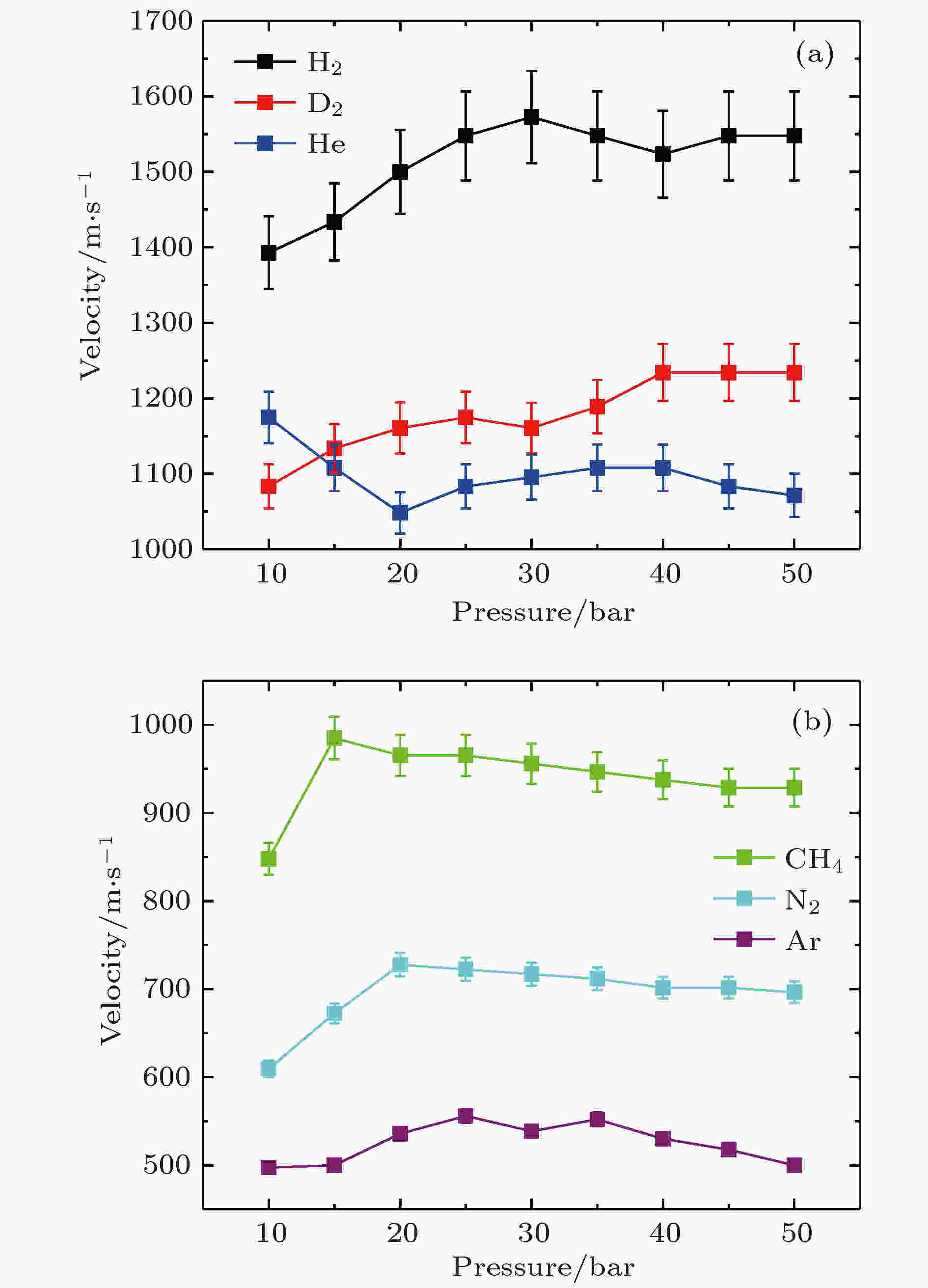 图 4 H2, D2和He分子束(a), 以及N2, Ar和CH4分子束(b)的飞行速度随源压强的变化曲线
图 4 H2, D2和He分子束(a), 以及N2, Ar和CH4分子束(b)的飞行速度随源压强的变化曲线Figure4. The curves of the velocities of H2, D2 and He molecular beams (a) and N2, Ar and CH4 molecular beams (b) with pressure.
实验结果显示, H2分子束的速度为1392—1572 m/s, 高于董贾福等[11]在背景真空度10–3 Pa以10 bar源压强产生的超声分子束的测量速度结果1200 m/s; 而与赵大为[35]在背景真空度1×10–4 Pa以源压强6 bar产生的超声分子束的测量速度结果1682 m/s较为接近; 并且, 该速度仅占氢气理论极限速度2931 m/s的54%. D2的速度在1083—1234 m/s之间, 为其极限速度2086 m/s的60%, 该结果与采用飞行时间质谱方法在T0 = 310 K时测量得到的D2束流速度(1925—2025 m/s)[8]相比, 速度明显降低. He的速度在1048—1174 m/s, 也小于Eder [36]等利用飞行时间质谱法实验测得的1760—1780 m/s和Christen [18]利用飞行时间质谱法测得的1825 m/s的结果, 且只占其理论极限速度1757 m/s的68%. 这也说明, 对于超声分子束注入(SMBI)加料研究, 由于采用自由膨胀束流, 且喷气时间较长(毫秒量级), 受实际分子间相互作用影响较大, 不能直接采用之前飞行时间质谱法测量的接近理想状况的结果.
而对于N2, CH4和Ar分子束, 它们的速度同各自极限速度较为接近: 甲烷分子束的平均速度占其极限速度1157 m/s的85%; 氮气分子束平均速度为其极限速度786 m/s的92%; 氩气分子束的平均速度非常接近极限速度557 m/s.
超声分子束速度和分子量的关系如图5所示. 结果表明, 尽管小于理想极限速度, 实验中分子束速度与分子量仍然成反比, 且分子量越大越接近极限速度. 我们认为当测量得到的速度接近估算的极限速度时, 束流中有团簇生成. 如表1所列, 对比结果表明, 利用本实验所采用的圆柱喷嘴, 常温下, H2, D2和He束流不能形成团簇, 而CH4, Ar和N2束流能够形成团簇. 为了对以上的束流成团估计进行验证, 利用Hagena经验公式[37], 也可以观察束流在不同源温度下的成团情况. Hagena经验公式表示为
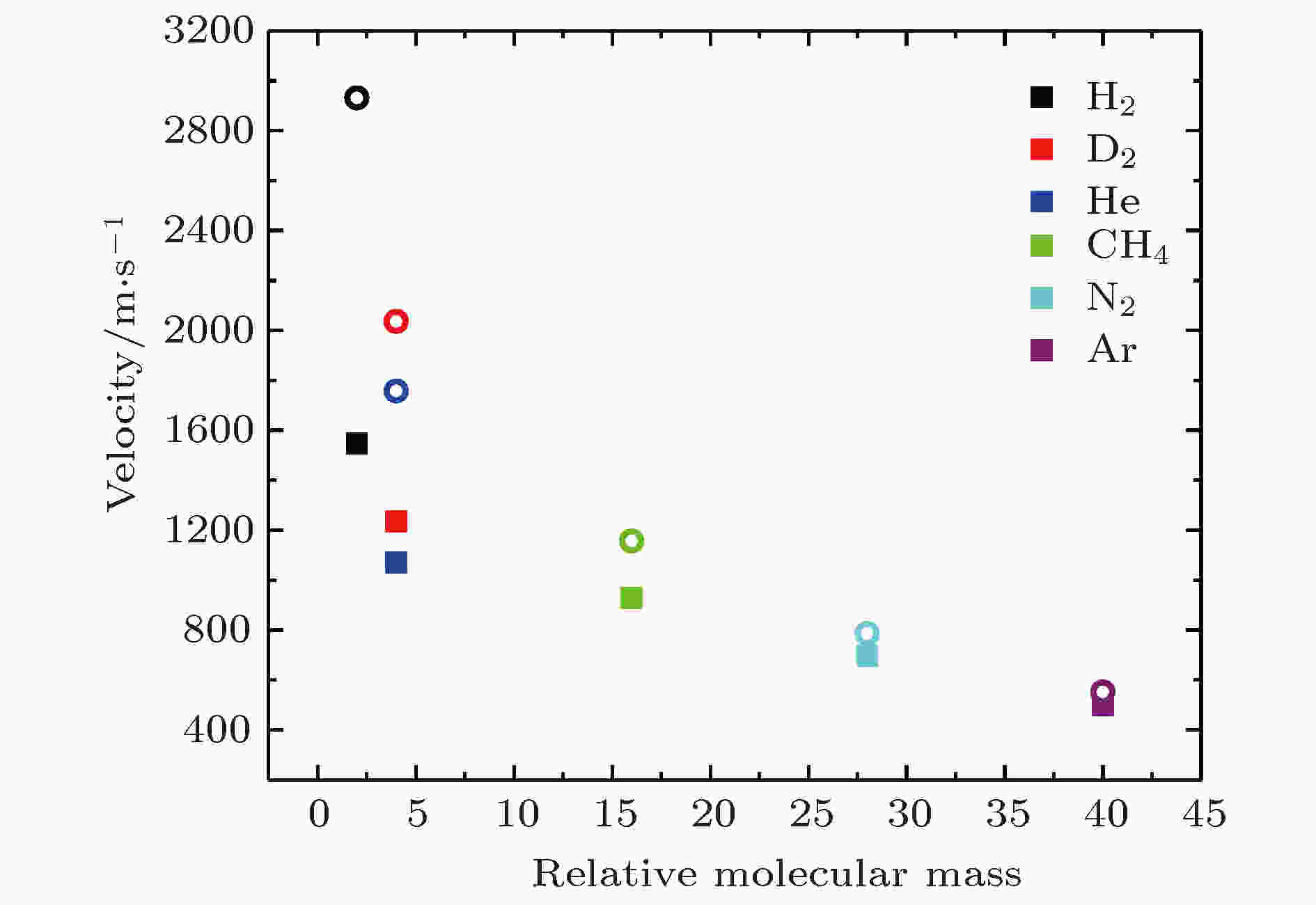 图 5 六种超声分子束的速度与分子量之间的关系 实心方形■代表在50 bar源压强下速度的测量结果, 空心圆○代表估算的极限速度结果
图 5 六种超声分子束的速度与分子量之间的关系 实心方形■代表在50 bar源压强下速度的测量结果, 空心圆○代表估算的极限速度结果Figure5. The relationship between the velocities of the six supersonic molecular beams and their molecular weights. The solid square ■ represents the measured velocity at 50 bar source pressure, and the hollow circle ○ represents the estimated limit velocity.
| Gas | H2 | D2 | N2 | Ar | He | CH4 |
| T/℃ | 22 | 26 | 24 | 26 | 24 | 24 |
| vfit/m·s–1 | 1392—1572 | 1083—1234 | 609—727 | 497—556 | 1048—1174 | 847—984 |
| vlim/m·s–1 | 2931 | 2086 | 786 | 557 | 1757 | 1157 |
表1H2, D2, N2, Ar, He和CH4的实验拟合速度和各自极限速度的对比
Table1.Comparison of the experimental fitting velocities and the limit velocities of H2, D2, N2, Ar, He and CH4.
2
3.4.低温下H2和D2分子束的速度
由于低温下氢气H2/氘气D2分子束能聚集产生团簇[38,39], 为了测量低温对较大范围分子束平均速度的影响, 本文还对低温下H2和D2超声分子束流速度进行了测量. 实验发现, H2和D2束流速度随温度的增加而增大, 如图6所示, 图中黑色虚线表示利用(3)式估算的超声分子束极限速度结果. 对比可知, 只有在低温下H2和D2束流的速度才与极限速度接近, 而温度越高束流速度与极限速度的差距越大. 这表明, 随着源温度的增加, 气流的末态温度越高, 也就越难以形成团簇. 对比结果还表明, 随着源温度的降低, 与H2分子束相比, D2分子束的速度更容易接近极限速度.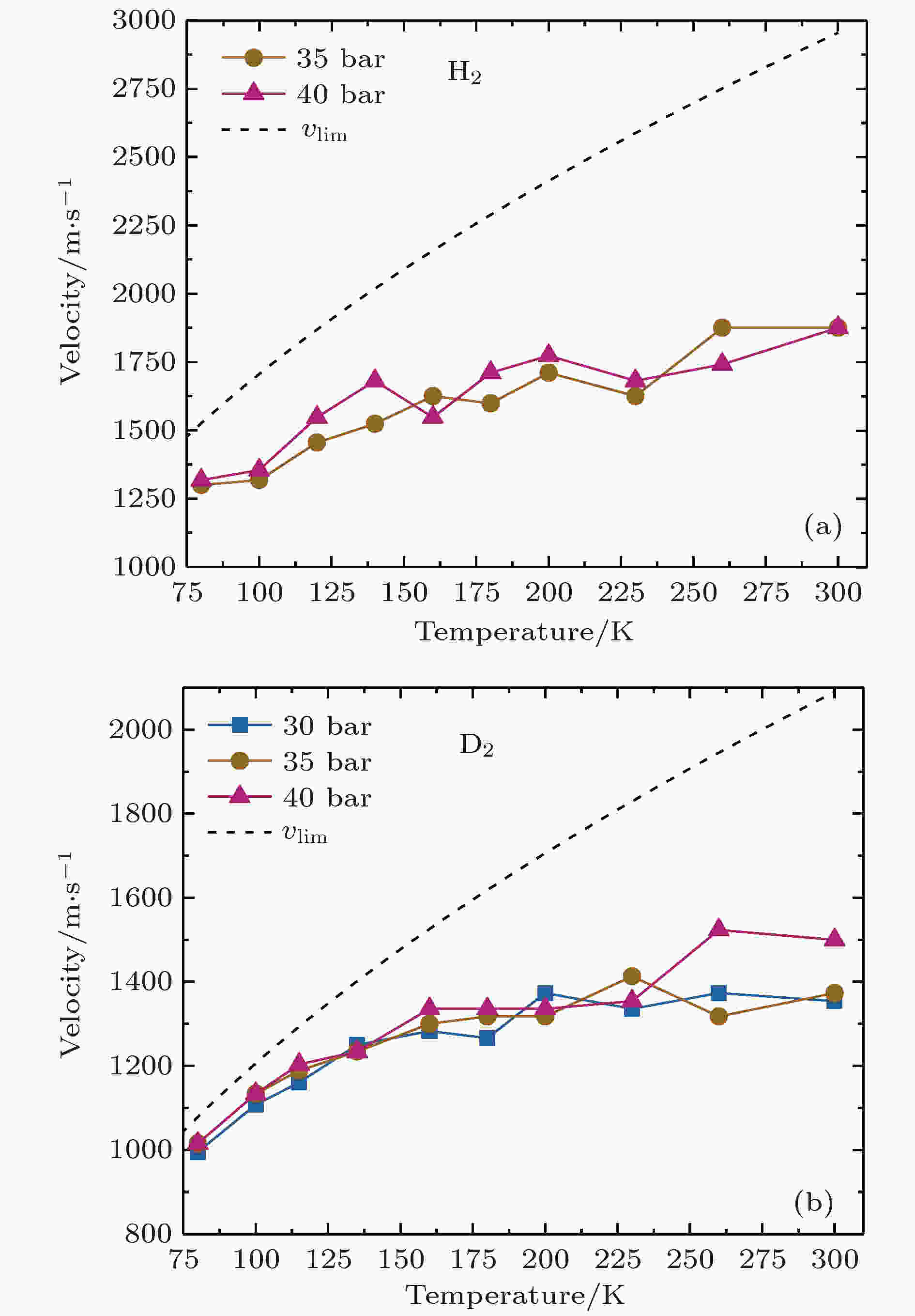 图 6 H2(a), D2(b)超声束速度随温度的变化结果
图 6 H2(a), D2(b)超声束速度随温度的变化结果Figure6. The variation of supersonic H2(a) and D2(b) beam velocity with temperature.
